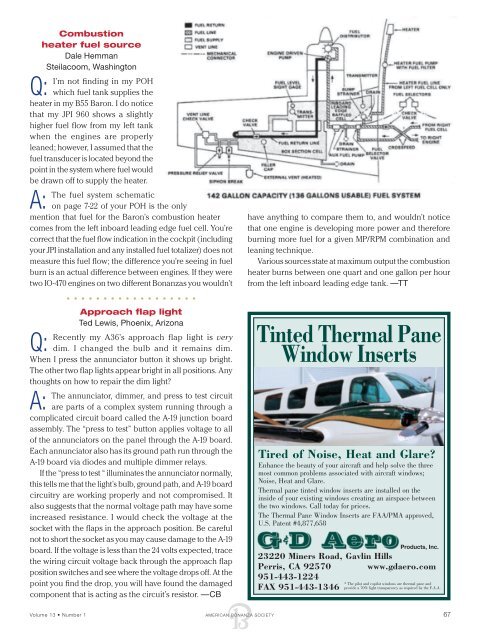Insurance Discount May Pay for Your BPPP Training - American ...
Insurance Discount May Pay for Your BPPP Training - American ...
Insurance Discount May Pay for Your BPPP Training - American ...
You also want an ePaper? Increase the reach of your titles
YUMPU automatically turns print PDFs into web optimized ePapers that Google loves.
Q:<br />
Combustion<br />
heater fuel source<br />
Dale Hemman<br />
Steilacoom, Washington<br />
I’m not finding in my POH<br />
which fuel tank supplies the<br />
heater in my B55 Baron. I do notice<br />
that my JPI 960 shows a slightly<br />
higher fuel flow from my left tank<br />
when the engines are properly<br />
leaned; however, I assumed that the<br />
fuel transducer is located beyond the<br />
point in the system where fuel would<br />
be drawn off to supply the heater.<br />
A:<br />
The fuel system schematic<br />
on page 7-22 of your POH is the only<br />
mention that fuel <strong>for</strong> the Baron’s combustion heater<br />
comes from the left inboard leading edge fuel cell. You’re<br />
correct that the fuel flow indication in the cockpit (including<br />
your JPI installation and any installed fuel totalizer) does not<br />
measure this fuel flow; the difference you’re seeing in fuel<br />
burn is an actual difference between engines. If they were<br />
two IO-470 engines on two different Bonanzas you wouldn’t<br />
have anything to compare them to, and wouldn’t notice<br />
that one engine is developing more power and there<strong>for</strong>e<br />
burning more fuel <strong>for</strong> a given MP/RPM combination and<br />
leaning technique.<br />
Various sources state at maximum output the combustion<br />
heater burns between one quart and one gallon per hour<br />
from the left inboard leading edge tank. —TT<br />
Q:<br />
Approach flap light<br />
Ted Lewis, Phoenix, Arizona<br />
Recently my A36’s approach flap light is very<br />
dim. I changed the bulb and it remains dim.<br />
When I press the annunciator button it shows up bright.<br />
The other two flap lights appear bright in all positions. Any<br />
thoughts on how to repair the dim light?<br />
A:<br />
The annunciator, dimmer, and press to test circuit<br />
are parts of a complex system running through a<br />
complicated circuit board called the A-19 junction board<br />
assembly. The “press to test” button applies voltage to all<br />
of the annunciators on the panel through the A-19 board.<br />
Each annunciator also has its ground path run through the<br />
A-19 board via diodes and multiple dimmer relays.<br />
If the “press to test “ illuminates the annunciator normally,<br />
this tells me that the light’s bulb, ground path, and A-19 board<br />
circuitry are working properly and not compromised. It<br />
also suggests that the normal voltage path may have some<br />
increased resistance. I would check the voltage at the<br />
socket with the flaps in the approach position. Be careful<br />
not to short the socket as you may cause damage to the A-19<br />
board. If the voltage is less than the 24 volts expected, trace<br />
the wiring circuit voltage back through the approach flap<br />
position switches and see where the voltage drops off. At the<br />
point you find the drop, you will have found the damaged<br />
component that is acting as the circuit’s resistor. —CB<br />
Tinted Thermal Pane<br />
Window Inserts<br />
Tired of Noise, Heat and Glare?<br />
Enhance the beauty of your aircraft and help solve the three<br />
most common problems associated with aircraft windows;<br />
Noise, Heat and Glare.<br />
Thermal pane tinted window inserts are installed on the<br />
inside of your existing windows creating an airspace between<br />
the two windows. Call today <strong>for</strong> prices.<br />
The Thermal Pane Window Inserts are FAA/PMA approved,<br />
U.S. Patent #4,877,658<br />
Products, Inc.<br />
23220 Miners Road, Gavlin Hills<br />
Perris, CA 92570 www.gdaero.com<br />
951-443-1224<br />
FAX 951-443-1346<br />
* The pilot and copilot windows are thermal pane and<br />
provide a 70% light transparency as required by the F.A.A.<br />
Volume 13 • Number 1 AMERICAN BONANZA SOCIETY 67

















